PDF Attached
US
and Canada are on holiday Monday. Friday we saw some positioning early ahead of the three day holiday weekend. CBOT soybeans extended gains on SA dryness concerns. Meal was lower and after a two-sided trade soybean oil closed higher, in part of WTI crude
oil pairing some losses in the nearby contract. For the week soybean oil made an impressive gain over soybean meal. Rain is forecast to show up late this month for Argentina and southern Brazil, but models vary for intensity. Corn was higher led by March
from talk of Chinese demand, although nothing showed up this week to confirm that. Chicago wheat settled mixed while KC and MN rallied. CFTC Commitment of Traders report showed funds were more long than estimated for CBOT soybeans and meal. They were in line
with corn and less long than expected for soybean oil. We see no impact on futures prices when they reopen Monday as the trade will be digesting three days of weather model changes for South America.
Private
exporters reported sales of 198,000 metric tons of soybeans for delivery to unknown destinations. Of the total, 66,000 metric tons is for delivery during the 2021/2022 marketing year and 132,000 metric tons is for delivery during the 2022/2023 marketing year.

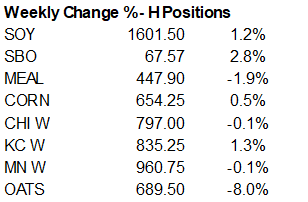
Argentina’s
central and southern areas may still see good rain during the 23-25 February period, before getting rain bias north during the 25-26 period. Southern Brazil will also see rain later this month. Northern and central Brazil weather will improve with less precipitation
than that of this week. 23-25 period below.
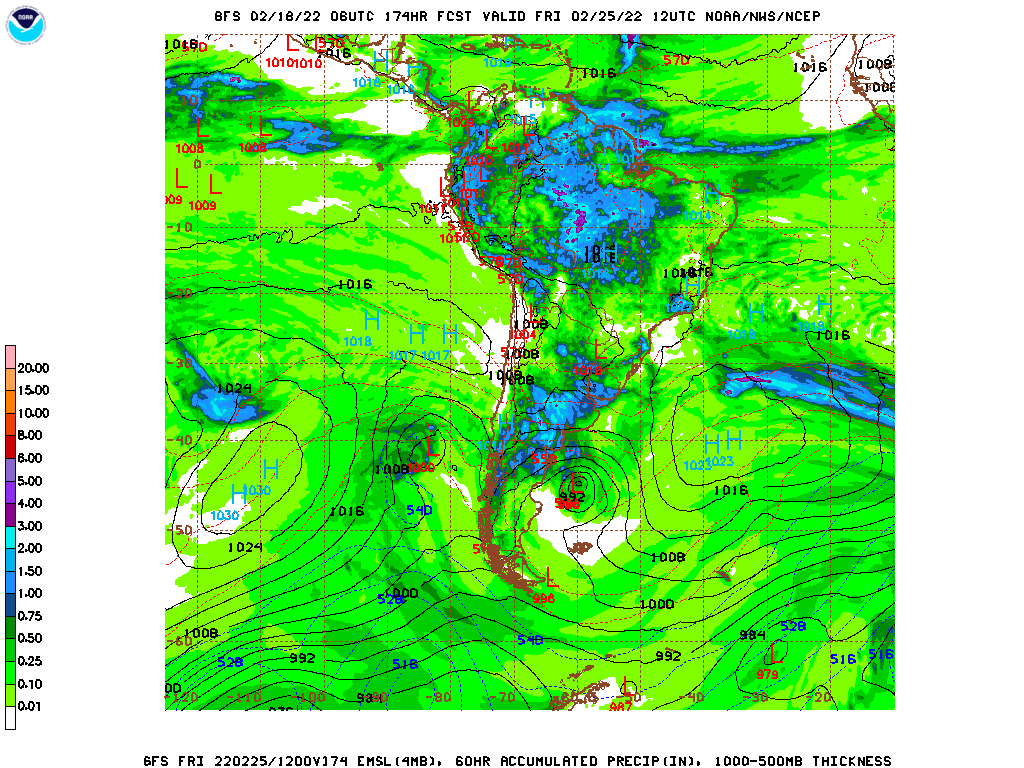
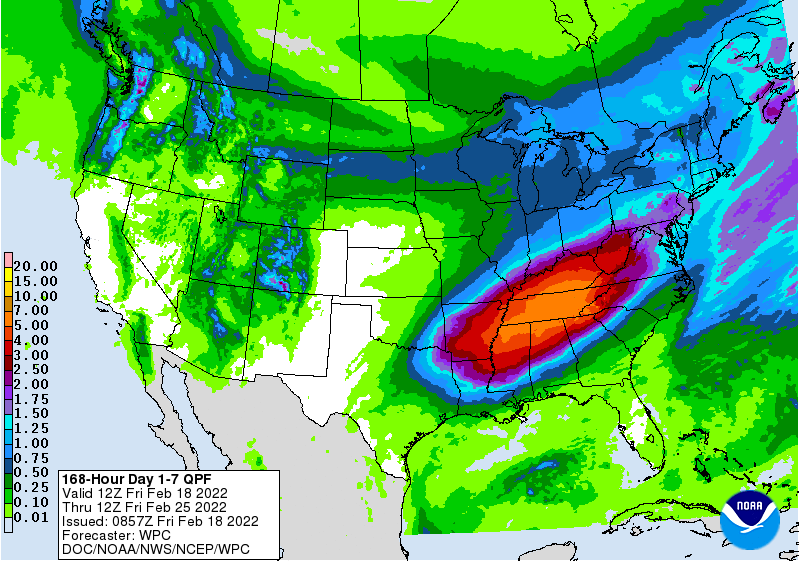
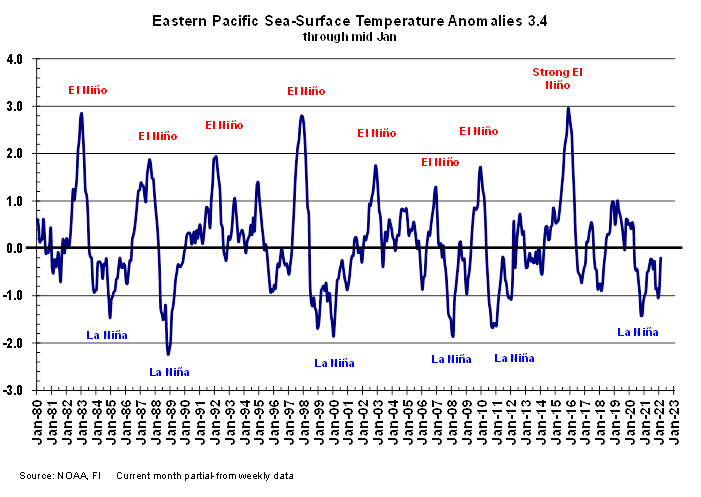
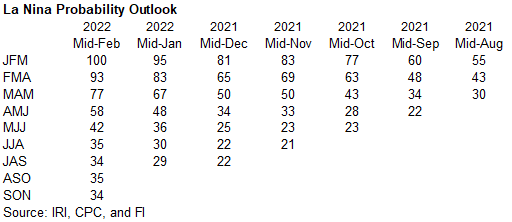
WORLD
WEATHER HIGHLIGHTS FOR February 18, 2022
- The
European model run was wetter in Argentina during the second week of the outlook today.
- Rain
is advertised Wednesday, Thursday and again Feb. 27 with enough to improve soil moisture in at least a part of the driest region.
- Additional
adjustments to the second week South America outlook are anticipated over the weekend with the bottom line allowing some rain into central and southern Argentina periodically while the north stays dry biased.
- Paraguay
and southwestern Brazil will also receive less than usual rainfall during the coming ten days to two weeks, although some showers will occur periodically.
- The
resulting rain amounts will help slow crop deterioration, but it may not be enough to turn around crop conditions that may still deteriorate for a while especially into early next week.
- In
the U.S., concern is rising over too much moisture in the spring for areas from the lower Ohio River Valley southward to the Tennessee River Basin and northern Delta.
- Rain
in those areas Thursday has the ground saturated and poised for a more significant bout of runoff and flooding as greater rain falls next week from Tuesday night into Friday.
- Rainfall
of 2.00 to 5.00 inches will be sufficient to cause flooding, although it may not be severe quite yet.
- There
will be more rain in March impacting these same areas. - U.S.
hard red winter wheat areas will get a little moisture periodically over the next couple of weeks but resulting amounts will still be too light for a serious change in soil moisture throughout the high Plains.
- Not
much changed in the remainder of the world - There
is still some interest over west-central Africa rainfall for coffee and cocoa, but World Weather, Inc. believes seasonal rainfall will increase gradually during March and that delayed showers in February will not have much impact on the bottom line.
- Most
of Europe and Asia will not encounter any threatening cold weather to winter crops over the next ten days - Eastern
Australia is still expecting some beneficial rainfall next week - South
Africa will dry down next week - A
few showers in the Iberian Peninsula and northwestern Africa over the next ten days will have little influence on the status of dryness in the region.
Source:
World Weather Inc.
Cold
next week for the US HRW wheat areas…
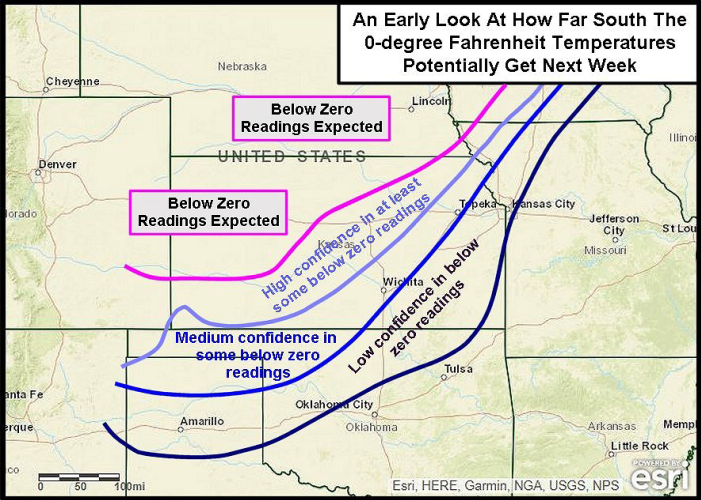
Source:
World Weather Inc.
Bloomberg
Ag Calendar
- Monthly
MARS bulletin on crop conditions in Europe - USDA
export inspections – corn, soybeans, wheat, 11am - Malaysia’s
Feb. 1-20 palm oil export data - Ivory
Coast cocoa arrivals - HOLIDAY:
U.S., Canada
Tuesday,
Feb. 22:
- EU
weekly grain, oilseed import and export data - Brazil’s
Unica may release cane crush and sugar output data during the week (tentative) - U.S.
cold storage data for beef, pork and poultry, 3pm - EARNINGS:
Wilmar International
Wednesday,
Feb. 23:
- USDA
total milk production, 3pm - EARNINGS:
IOI Corp. - HOLIDAY:
Japan, Russia
Thursday,
Feb. 24:
- USDA
weekly net-export sales for corn, soybeans, wheat, cotton, pork and beef, 8:30am - USDA
corn, cotton, soybean and wheat acreage outlook, 8:30am - EIA
weekly U.S. ethanol inventories, production, 11am - U.S.
red meat production, 3pm
Friday,
Feb. 25:
- ICE
Futures Europe weekly commitments of traders report, ~1:30pm - CFTC
commitments of traders weekly report on positions for various U.S. futures and options, 3:30pm - USDA
corn, cotton, soybean and wheat end-stockpile outlook, 8:30am - FranceAgriMer
weekly update on crop conditions - Malaysia’s
Feb. 1-25 palm oil exports - U.S.
cattle on feed, 3pm
Source:
Bloomberg and FI
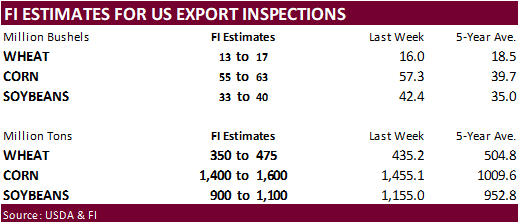
CFTC
Commitment of Traders report
The
traditional fund was more long than estimated for soybeans and meal. They were in line with corn and less long than expected for soybean oil. We see no impact on futures prices when they reopen Monday as the trade will be digesting three days of weather
model changes for South America.






SUPPLEMENTAL
Non-Comm Indexes Comm
Net Chg Net Chg Net Chg
Corn
259,453 5,840 434,908 -6,847 -666,112 3,596
Soybeans
140,298 776 190,352 2,553 -297,073 -5,534
Soyoil
31,737 -812 120,689 1,720 -166,335 -2,405
CBOT
wheat -55,988 -5,754 146,811 3,650 -87,336 1,895
KCBT
wheat 12,614 748 57,435 337 -70,607 1,285
=================================================================================
FUTURES
+ OPTS Managed Swaps Producer
Net Chg Net Chg Net Chg
Corn
325,514 -11,818 289,981 11,311 -667,107 -4,189
Soybeans
175,372 9,057 131,763 4,458 -306,822 -10,297
Soymeal
89,170 1,031 92,305 -645 -227,598 -932
Soyoil
70,381 -2,402 91,982 2,356 -173,658 -2,362
CBOT
wheat -34,658 -5,106 96,188 2,576 -71,311 1,603
KCBT
wheat 36,050 1,578 26,919 -66 -61,033 789
MGEX
wheat 5,268 1,672 2,107 -259 -17,004 -2,264
———- ———- ———- ———- ———- ———-
Total
wheat 6,660 -1,856 125,214 2,251 -149,348 128
Live
cattle 86,061 4,219 83,598 -281 -170,896 -4,658
Feeder
cattle 3,256 2,541 6,954 388 -2,619 -1,034
Lean
hogs 79,242 571 62,392 305 -135,250 -2,113
Other NonReport Open
Net Chg Net Chg Interest Chg
Corn
79,860 7,285 -28,249 -2,589 2,062,677 64,665
Soybeans
33,264 -5,421 -33,577 2,204 1,124,836 46,146
Soymeal
16,866 1,386 29,259 -840 524,560 14,213
Soyoil
-2,613 911 13,908 1,498 486,365 1,797
CBOT
wheat 13,267 718 -3,487 210 511,039 24,561
KCBT
wheat -2,495 69 558 -2,370 249,029 8,655
MGEX
wheat 4,783 874 4,846 -24 74,066 1,797
———- ———- ———- ———- ———- ———-
Total
wheat 15,555 1,661 1,917 -2,184 834,134 35,013
Live
cattle 21,479 2,314 -20,241 -1,594 406,721 14,573
Feeder
cattle 2,453 -753 -10,045 -1,142 58,181 1,799
Lean
hogs 7,383 1,132 -13,768 106 367,616 9,460
=================================================================================
Source:
Reuters, CFTC and FI
Macros
Canadian
Retail Sales (M/M) Dec: -1.8% (est -2.1%; prev 0.7%)
–
Retail Sales Ex Auto (M/M) Dec: -2.5% (est -1.5%; prev 1.1%)
Canadian
Retail Sales – Retail sales fell 1.8% to $57.0 billion in December. Lower sales at clothing and clothing accessories stores (-9.5%) and furniture and home furnishings stores (-11.3%) led the decline, which coincided with concerns over the spread of the COVID-19
Omicron variant in December.
79
Counterparties Take $1.675 Tln At Fed Reverse Repo Op (prev $1.647 Tln, 79 Bids)
Corn
·
Corn was higher on Friday led by March position from talk of Chinese demand, although nothing showed up this week to confirm that.
·
CBOT corn futures ended 1.00-4.25 cents higher.
·
March WTI was trading about 50 cents lower while the back months were higher around the time corn settled. March WTI goes off the board Tuesday and Monday is a US holiday.
·
China granted imports of Chile beef and mutton products, another portal that extends their importing country list to ensure food security.
Export
developments.
- Iran’s
SLAL bought about 120,000 tons of feed barley, 120,000 tons of feed corn and 180,000 tons of soybean meal. Prices were not available. Shipment for all the grains and soymeal was sought in February and March. On Feb. 11 they passed on 60,000 tons of feed
barley and 60,000 tons of soymeal.
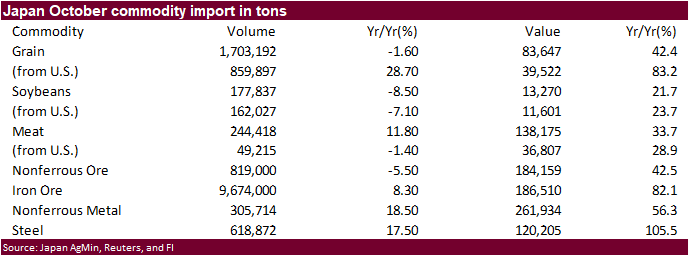

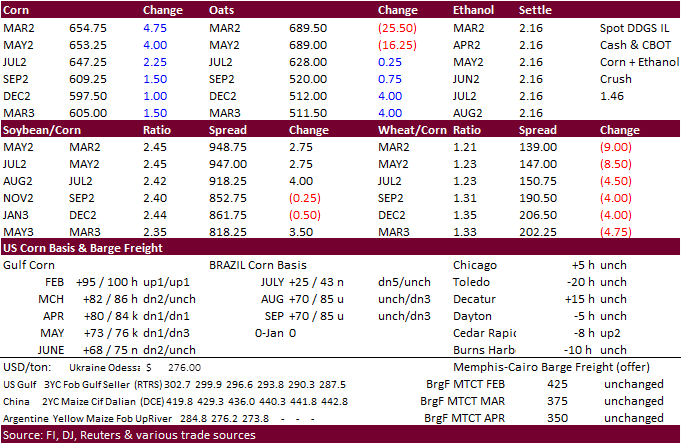
Updated
2/11/22
March
corn is seen in a $6.15 and $6.85 range
December
corn is seen in a wide $5.25-$7.00 range
·
March soybeans took out yesterday’s high during morning trade. Soybeans closed higher on ongoing SA weather concerns and general commodity buying as Ukraine/Russian tensions persist. Weekend profit taking dried up by early morning.
·
China needs to sell soybeans from reserves to satisfy spot consumption. We are hearing some crushing plants are very short of soybeans. If they ramp up to a 1.7 million ton crush this week, post to a slow holiday crush of less
than 700,000 tons, they need soybeans.
·
A Reuters poll averaged 113 million tons for Brazil soybean production. Lowest estimated was 106.8 million tons and highest 116.8 million.
·
Reuters noted overnight that India contracted to import a record 100,000 tons of soyoil from the United States. Nearly 100,000 tons has been recorded for accumulated exports, not including unknown, per USDA export sales.
·
No US soybean oil was reported under the 24-hour reporting system for Friday. 198,000 tons of soybeans were sold to unknown, split crop years. We think there could be a Tuesday morning announcement if India was still in negotiations.
- Private
exporters reported sales of 198,000 metric tons of soybeans for delivery to unknown destinations. Of the total, 66,000 metric tons is for delivery during the 2021/2022 marketing year and 132,000 metric tons is for delivery during the 2022/2023 marketing year. - Iran’s
SLAL bought about 120,000 tons of feed barley, 120,000 tons of feed corn and 180,000 tons of soybean meal. Prices were not available. Shipment for all the grains and soymeal was sought in February and March. On Feb. 11 they passed on 60,000 tons of feed
barley and 60,000 tons of soymeal. - Turkey
seeks 6,000 tons of sunflower oil on February 23 for shipment between March 2 and March 25.
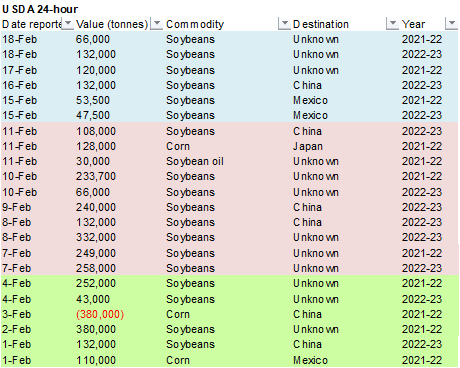
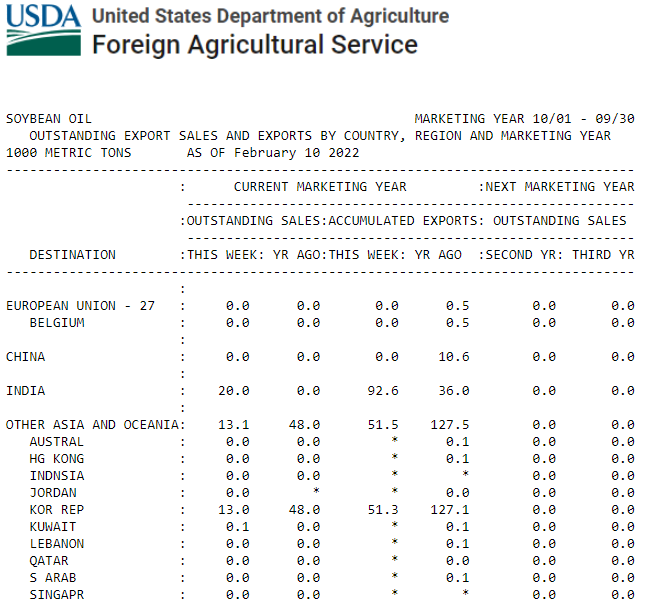
India
Ministry of Agriculture and Farmers Welfare – 2021-22 oilseeds
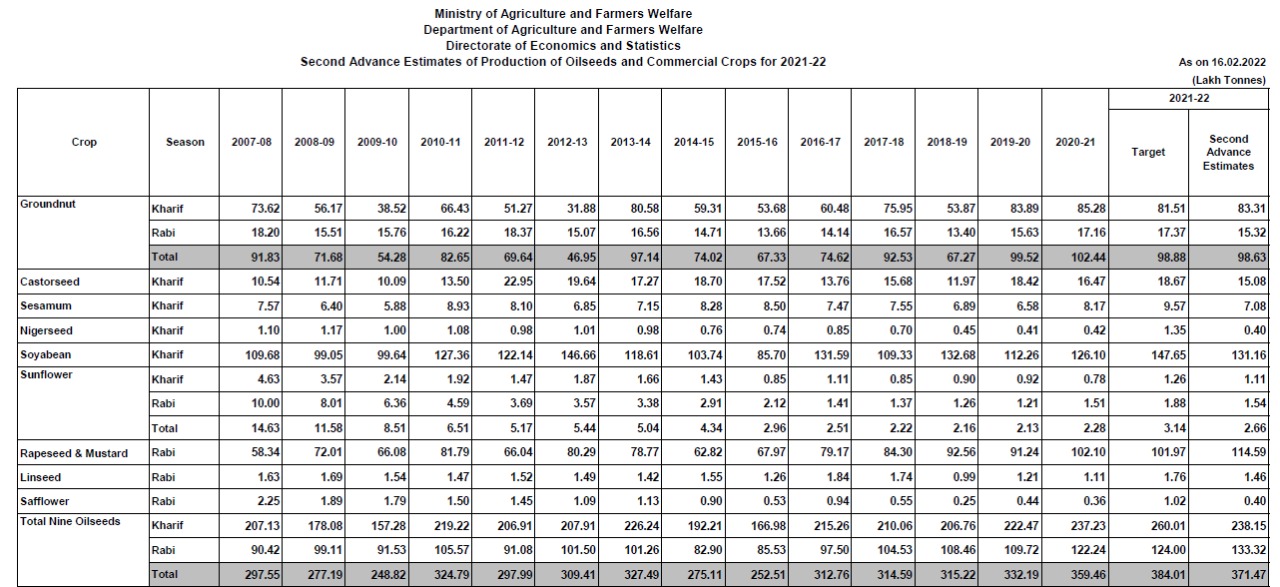
Soybean
oil share – July
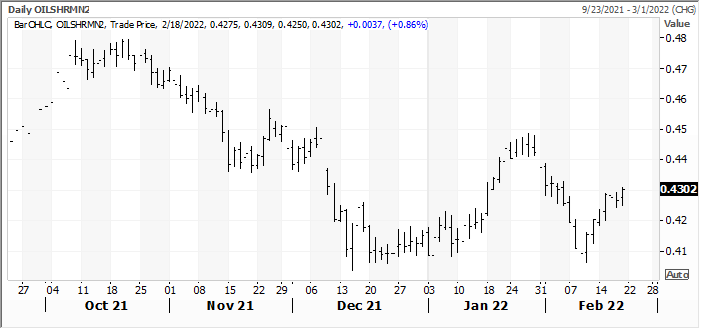
Source:
Reuters and FI
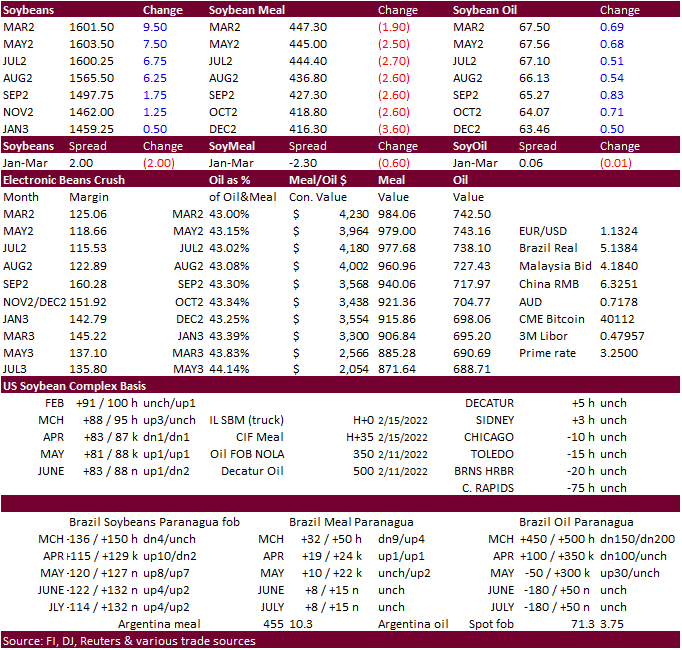
Updated
2/15/22
Soybeans
– March $14.75-$16.50
Soybeans
– November is seen in a wide $12.00-$15.75 range
Soybean
meal – March $420-$480
Soybean
oil – March 64.00-68.00
·
US wheat was higher for higher protein contracts on Black Sea shipping concerns as Ukraine/Russian tensions continue to spook traders. Chicago, the heavily weighted fund wheat contract, ended mixed. Positioning was noted.
·
May EU wheat futures that were trading up 7.00 euros at 275.75 euros per ton.
·
Other than political/headline news, we have not seen much to reports for Friday’s trade.
·
Export development were routine on Friday and as expected.
·
China is a wait and see if they are serios on cutting back on soybean dependency. Any soybean import cuts could lead to significant increase in imports of feedgrains.
·
Taiwan bought 54,920 tons of US wheat for April 4-18 shipment if off the PNW.
o
32,360 tons of U.S. dark northern spring wheat of 14.5% protein content bought at $409.69 a ton FOB
o
15,115 tons of hard red winter wheat of 12.5% protein was bought at $396.37 a ton FO
o
7,445 tons of soft white wheat of 10.5% protein was bought at $406.29 a ton FOB.
o
freight $52.79 per ton
·
Turkey seeks 255,000 tons of feed barley on February 22. Shipment is sought for March 1-31.
·
Jordan seeks 120,000 tons of feed barley on February 22 for late July through FH September shipment.
·
Jordan’s state grain buyer seeks 120,000 tons of milling wheat, optional origins, on Feb. 23, with shipment in 60,000 ton consignments, for July 16-31, Aug. 1-15, Aug. 16-31 and Sept. 1-15. They also seek 120,000 tons of feed
barley on Feb. 22.
Rice/Other
·
South Korea seeks 72,200 tons rice from U.S. and Vietnam on Feb. 25.
·
(Reuters) – China’s state planner on Friday issued the minimum purchase prices for some rice products for 2022. The National Development and Reform Commission (NDRC) set the minimum purchase prices for early indica, late indica
and japonica rice at 124 yuan, 129 yuan and 131 yuan per 50kg respectively. That works out at a minimum purchase price of 2,480 yuan ($392.14), 2,580 yuan and 2,620 yuan per ton respectively. The prices are also higher than those set for 2021, signaling increasing
support for production of the crop.

Updated
2/2/22
Chicago
March $7.25 to $8.30 range
KC
March $7.45 to $8.55 range
MN
March $8.75‐$10.00
Terry Reilly
Senior Commodity Analyst – Grain and Oilseeds
Futures International
One Lincoln Center
18 W 140 Butterfield Rd.
Oakbrook Terrace, Il. 60181
W: 312.604.1366
ICE IM:
treilly1
Skype: fi.treilly

Trading of futures, options, swaps and other derivatives is risky and is not suitable for all persons. All of these investment products are leveraged, and you can lose more than your initial deposit. Each investment product is offered
only to and from jurisdictions where solicitation and sale are lawful, and in accordance with applicable laws and regulations in such jurisdiction. The information provided here should not be relied upon as a substitute for independent research before making
your investment decisions. Futures International, LLC is merely providing this information for your general information and the information does not take into account any particular individual’s investment objectives, financial situation, or needs. All investors
should obtain advice based on their unique situation before making any investment decision. The contents of this communication and any attachments are for informational purposes only and under no circumstances should they be construed as an offer to buy or
sell, or a solicitation to buy or sell any future, option, swap or other derivative. The sources for the information and any opinions in this communication are believed to be reliable, but Futures International, LLC does not warrant or guarantee the accuracy
of such information or opinions. Futures International, LLC and its principals and employees may take positions different from any positions described in this communication. Past results are not necessarily indicative of future results.
